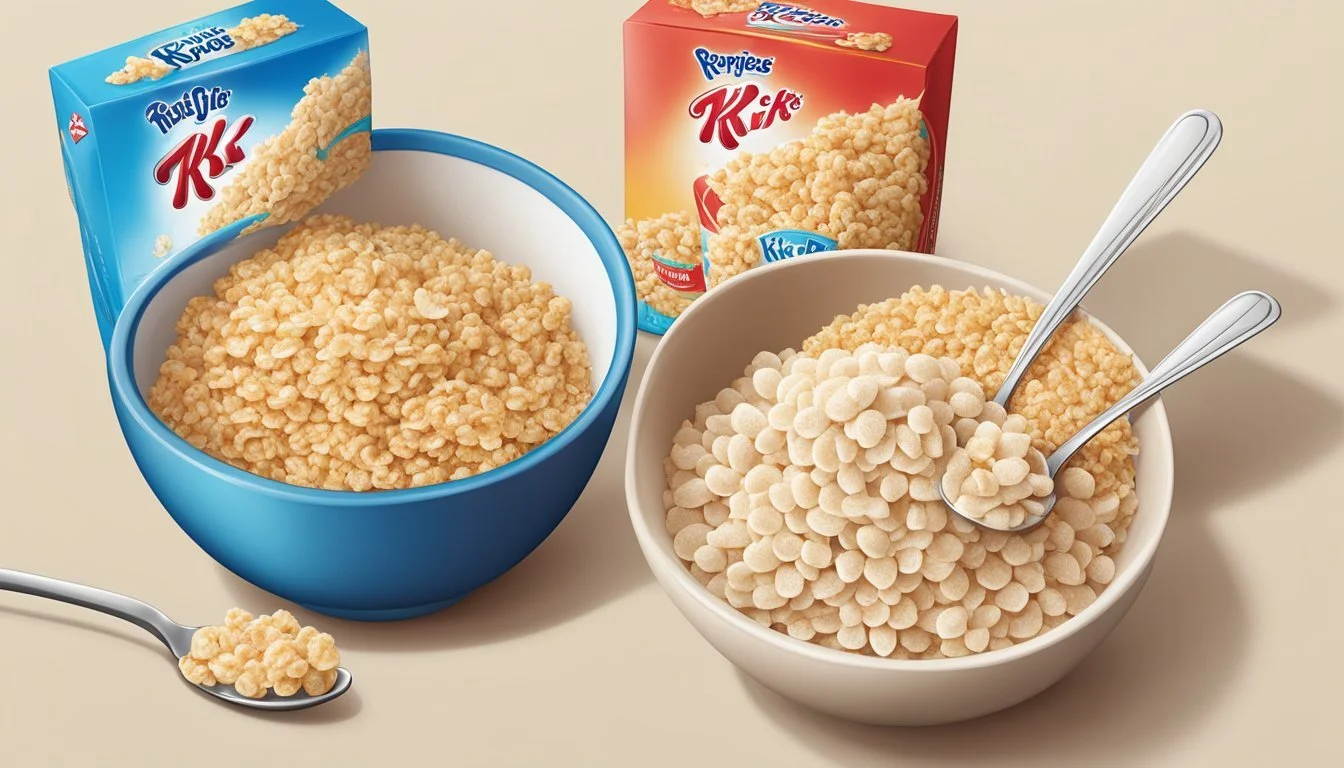Rice Krispies vs Special K
Nutritional Comparison and Benefits
This Article is Part of Our Breakfast Cereal Guide with Details on Rice Krispies Nutrition and Special K Nutrition
When choosing between Rice Krispies and Special K for breakfast, it's essential to understand their nutritional differences. Both cereals are popular choices from Kellogg's, but they serve different nutritional needs and preferences. Special K contains more fiber than Rice Krispies, making it a slightly healthier option for those focusing on dietary fiber intake.
Rice Krispies, with its 22.0 grams of complex carbohydrates per serving, offers a crunchier texture suitable for those who enjoy a lighter breakfast. Special K, containing 16.0 grams of complex carbohydrates per serving, tends to appeal to those seeking a balance between protein and fiber while keeping calories low.
In comparing these two cereals, it's clear that there are trade-offs depending on what you prioritize in your diet. Special K stands out for those focusing on balanced nutrition with a slight edge in fiber content, while Rice Krispies cater to those who prefer a classic, lower-calorie choice.
Nutritional Profiles
The nutritional profiles of Rice Krispies and Special K highlight key differences in their caloric content, macronutrient composition, and vitamin and mineral content. Each cereal offers distinct benefits and drawbacks depending on dietary needs and health goals.
Caloric Content
Rice Krispies and Special K differ in their caloric content.
Rice Krispies provides approximately 130 calories per 1-cup serving.
Special K, on the other hand, contains around 120 calories per serving of the same size.
These calorie differences are minor but might matter for those tracking every calorie for weight loss or maintenance.
Macronutrient Comparison
Macronutrient composition includes protein, carbs, and fat.
Rice Krispies has 3 grams of protein, 29 grams of carbohydrates, and 0.5 grams of fat per serving. Notably, it has 2 grams of sugar and 0 grams of fiber.
Special K offers 7 grams of protein, 23 grams of carbs, and 0.5 grams of fat per serving. It includes 4 grams of sugar and 2 grams of fiber, making it higher in both protein and fiber.
Vitamin and Mineral Content
Special K is richer in vitamins and minerals compared to Rice Krispies.
Special K contains higher amounts of Vitamin B12, Vitamin B6, Iron, Folate, Vitamin E, Selenium, Vitamin C, Vitamin B2, Vitamin B3, and Vitamin B1.
Rice Krispies lacks substantial quantities of these vitamins and minerals, making Special K a more nutrient-dense option.
This comparison highlights that while both cereals serve as quick breakfast options, their nutritional benefits vary significantly.
Ingredient Analysis
When comparing Rice Krispies and Special K, several factors differentiate these two cereals, including whole grains, fiber content, sugar, sweeteners, and the use of additives and preservatives.
Whole Grains and Fibers
Special K contains whole grain wheat, which makes it higher in fiber compared to Rice Krispies. Whole grains are beneficial for digestive health and provide lasting energy levels. In contrast, Rice Krispies primarily use processed rice as their main ingredient, offering less fiber.
Special K Ingredients:
Whole grain wheat
Rice
Wheat bran
Rice Krispies Ingredients:
Milled rice
Sugar
Salt
The emphasis on whole grains in Special K makes it a healthier breakfast option for those seeking higher fiber intake.
Sugar and Sweeteners
Sugar content significantly varies between the two cereals. Rice Krispies have a higher amount of processed sugar, which can affect blood sugar levels. On the other hand, Special K usually contains less added sugar, making it a better choice for those aiming to reduce sugar consumption.
Rice Krispies:
High in processed sugar
Special K:
Lower in sugar
Occasionally sweetened with honey or dried fruits
The reduced sugar levels in Special K can help maintain a more balanced diet and avoid unnecessary sugar spikes.
Additives and Preservatives
The use of additives and preservatives is another distinguishing factor. Rice Krispies and Special K both include certain additives, though the types and quantities can vary.
Common Additives in Rice Krispies:
BHT (preservative)
Artificial flavors and colors
Common Additives in Special K:
BHT
Some versions contain artificial flavors, though healthier options eschew synthetic additives
Both cereals use BHT to extend shelf life, though consumers might prefer cereals free of artificial colors and flavors. Special K typically offers versions with fewer synthetic ingredients, appealing to those seeking more natural options.
Health Considerations
Choosing between Rice Krispies and Special K can impact various aspects of health, including diet, weight management, blood sugar control, cardiovascular health, and digestive benefits. Each of these subtopics addresses specific nutritional considerations relevant to selecting a healthier cereal option.
Diet and Weight Management
Special K is frequently promoted as a healthy breakfast option for those attempting weight loss. It contains 16 grams of complex carbohydrates per serving compared to Rice Krispies’ 22 grams. This lower carbohydrate content may contribute to better weight management. Additionally, Special K is lower in fat and often marketed as part of weight loss programs.
Rice Krispies, albeit with higher simple carbohydrates, might be less filling, leading to increased calorie consumption later in the day. For those focused on calorie control, Special K presents a more balanced choice with added vitamins and minerals.
Blood Sugar Control
Glycemic index (GI) plays a significant role in how cereals affect blood sugar levels. Rice Krispies have a higher glycemic index than Special K, which can result in quicker spikes in blood sugar levels followed by a potential sugar crash. This makes Rice Krispies less favorable for individuals managing blood sugar levels or diabetes.
Special K, with its lower glycemic index, can help better stabilize blood sugar. Consistent blood sugar management contributes to reduced cravings and sustained energy levels throughout the day.
Cardiovascular Health
When evaluating cereals for cardiovascular benefits, factors such as cholesterol and fat content are crucial. Special K excels here by being lower in saturated fat and cholesterol. It also contains essential vitamins like B6, B12, and folate which support heart health endorsed by organizations such as the American Heart Association.
Rice Krispies have a higher sugar content, which can negatively influence cardiovascular health by contributing to increased blood cholesterol levels. Special K’s composition makes it a superior option for those looking to protect their heart health.
Digestive Benefits
Dietary fiber content is essential for healthy digestion. Special K scores better with a higher fiber content compared to Rice Krispies, making it more beneficial for promoting regular bowel movements and preventing constipation. Increased fiber intake is also linked to better satiety and thus, might aid in weight management.
Rice Krispies lack significant fiber, offering minimal digestive benefits. For individuals looking for a cereal that contributes to digestive health, Special K is the healthier alternative due to its enriched fiber content and associated benefits.
Consumer Information
When comparing Rice Krispies and Special K, it is important to consider their popularity, market presence, demographic preferences, and labeling and packaging to understand consumer trends and choices.
Popularity and Market Presence
Both Rice Krispies and Special K have established strong market presence due to their longstanding history and broad availability. Rice Krispies, known for its iconic snap, crackle, and pop, appeals widely to children and families. Special K, by Kellogg's, markets itself as a health-conscious choice, particularly popular among adults.
Special K is often highlighted for being lower in sodium and containing added vitamins and minerals. Contrastingly, Rice Krispies is renowned for its simple ingredient list. Popular competitors in the market include Cheerios, Fiber One, Shredded Wheat, and Total, each targeting different consumer health needs and preferences.
Demographic Preferences
Rice Krispies appeals mostly to families and children due to its playful branding and sweet, crisp texture. Its versatile use in homemade cereal treats also enhances its popularity among younger demographics.
Special K targets health-conscious adults, marketing itself as a weight management solution. The cereal’s advertisements often focus on women aiming for fitness goals. Due to added vitamins and minerals, Special K is attractive to those seeking nutritional benefits in their breakfast cereal.
Products like Corn Flakes, Wheaties, and General Mills offerings also contend within these demographics, by providing both family-friendly and nutritional options.
Labeling and Packaging
Packaging plays a crucial role in consumer decision-making. Rice Krispies features vibrant, playful boxes with cartoon characters, making it visually appealing to children. The packaging emphasizes simplicity and fun.
Special K adopts a sleek, minimalist design. Its packaging often showcases fitness imagery and highlights nutritional information prominently. Labels clearly list ingredients and health benefits, targeting individuals seeking a balanced diet.
Both cereals provide ingredient lists and nutritional details, facilitating informed decisions for consumers, especially those monitoring dietary restrictions like vegan options or added sugars. Comparatively, cereals like Cheerios and Fiber One adopt similar packaging strategies focusing on health benefits and ingredient transparency.
Brand Overview
Kellogg's has a longstanding reputation in the breakfast cereal market with iconic products like Rice Krispies and Special K. This section delves into the history of Kellogg's and the diverse range of products they offer.
History of Kellogg's
Kellogg's was founded by Will Keith Kellogg in 1906. Its legacy began in Battle Creek, Michigan. The company's mission centers on offering nutritious and convenient breakfast options.
Through product innovations and marketing, Kellogg's has grown to capture a significant percent of the cereal market share. It is responsible for beloved brands such as Raisin Bran, Rice Krispies, and Special K, each occupying a familiar spot on grocery shelves.
Product Varieties and Flavors
Kellogg's offers a range of products to cater to various tastes and dietary needs. Special K is known for its low-calorie options, with flavors like Red Berries and Chocolate Delight. It aims to support weight management and overall health.
Rice Krispies, famous for their "snap, crackle, and pop" sound, include varieties like Rice Krispies Treats and Cocoa Krispies. These cater to both traditional breakfast consumers and those seeking sweet snack alternatives.
Environmental and Ethical Considerations
Both Rice Krispies and Special K take steps toward sustainable agriculture. Kellogg's, the parent company, has initiatives focused on reducing their environmental impact. They aim to source rice and other grains responsibly, minimizing water usage and promoting soil health.
Eco-friendly packaging plays a crucial role in Kellogg's sustainability efforts. They are committed to reducing packaging waste. For instance, in Europe, they aim to cut 191 tonnes of packaging per year across several brands, including Special K.
Rice production's contribution to global methane emissions is significant. Rice Krispies addresses this by focusing on sustainable rice cultivation practices. These practices help reduce methane emissions, lowering the overall environmental impact.
Fair trade certifications are less commonly highlighted but are an essential aspect of ethical consumerism. While Kellogg's focuses extensively on environmental sustainability, integrating fair trade certifications could further enhance their ethical standing.
Efforts to make cereal production more sustainable are evident but still evolving. Continued improvements in both sustainable agriculture practices and eco-friendly packaging contribute to their ongoing sustainability journey. Depending on consumer demand, incorporating more comprehensive fair trade measures could be a future consideration.
Conclusions and Recommendations
In comparing Rice Krispies and Special K, several factors should influence consumer choices.
Nutritional Value:
Rice Krispies contain 22.0 grams of complex carbohydrates per serving.
Special K has 16.0 grams of complex carbohydrates per serving.
Special K is higher in vitamins such as Vitamin B12, Vitamin B6, Iron, Folate, Vitamin E, Selenium, Vitamin C, Vitamin B2, Vitamin B3, and Vitamin B1.
Best Cereals and Healthy Breakfast Alternatives:
While Rice Krispies offer more carbohydrates, Special K provides a broader spectrum of vitamins and minerals.
For those seeking higher vitamin intake, Special K is likely the better option.
If a consumer's priority is carbohydrate intake for energy, Rice Krispies may better meet their needs.
Taste and Texture:
Personal taste preference often plays a significant role in cereal selection.
Special K tends to have a crunchier texture, which some may find more satisfying.
Rice Krispies offer a lighter, crispier texture, making them more versatile for different breakfast applications.
Comparing these cereals to other options, consumers may want to consider Total Cereal, which has shown higher fiber content due to its whole-grain composition.
Special K is positioned closer to other nutrient-rich cereals, but still trails options with higher fiber content.
Overall, the choice between Rice Krispies and Special K will heavily depend on individual nutritional needs, taste preferences, and health goals. Each cereal has unique attributes that cater to different aspects of a balanced and varied diet.








